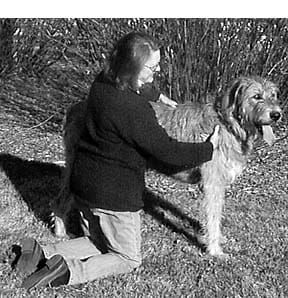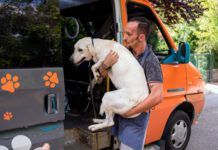Watching the smooth, even gait of a happy dog as it trots or gallops across a field is pure delight. It is obvious that all of the muscles and joints are working in harmony.
We don’t often stop to think about the importance of muscles as a dog stands quietly at our side, but the same muscles that act antagonistically to move joints as the dog runs must cooperate to stabilize those same joints and change the limb into a rigid support when standing. It’s really an amazing relationship.
In the forelimb, the triceps muscle is critical to maintaining the elbow in an extended position while the dog stands. As a matter of fact, three of the four parts or heads of the large, strong triceps muscle group are concerned with supporting the body weight against the pull of gravity. In a normal standing posture, the elbow is maintained in an extended position by isometric contraction of the parts of the triceps muscle that attach to the point of the elbow.
Isometric contraction means that tension is maintained in the muscle without actually shortening the muscle. The triceps works against the resistance provided by the dog’s weight which tends to flex or bend the elbow. If the muscles and/or tendons of the elbow are injured or not functioning efficiently, the dog may be unable to accept weight on that limb and will stand or move abnormally. Maintaining the suppleness of the triceps and associated muscles of the shoulder and upper arm is important for proper gait and posture.
Cross-fiber friction massage
The cross-fiber friction techniques employed in sports massage are very effective in working on the large muscle groups of both the fore- and hindlimbs. The term “friction” comes from the Latin word frictio which means “to rub.” In general, friction techniques are brisk, often heat-producing techniques. Remember that skeletal muscles are composed of many thin muscle fibers that run parallel to each other and parallel to the long axis of the muscle. Cross-fiber friction techniques work across the grain of these fibers in the muscle. These techniques increase blood flow to the area, are effective in treating many muscle injuries, and aid in breaking down adhesions by coaxing apart the adhered tissue.
Because the triceps and associated muscles are working to some degree whether a dog is moving or standing still, cross-fiber friction massage can have a positive effect by relieving tightness in the muscle.
Muscle texture
Before you begin the massage, take a few minutes to assess the general texture of the dog’s muscles. You can learn to test for muscle texture on your own forearm. Most adults have tight forearm muscles that feel like stringy ropes. Check out your muscles by resting one forearm and hand on a table. Place the pads of the fingers of your other hand on the fleshy part of the resting arm, about two or three inches below the elbow. Gently and slowly move the skin and underlying muscle back and forth. Continue working your way toward your wrist.
Some areas may feel fairly uniform in texture but you will probably find hard strings or ropes of muscle that are ¼ inch to perhaps ¾ inch or more in diameter. Since your arm muscles are not actively contracting or working, they should not be hard. The hard stringy texture indicates that the muscles are “resting” in a partially contracted state. Use digital circles or gently massage back and forth over the cords for a brief period. You should feel the cords relax and the muscle attain a more uniform texture.
Now check the texture of your dog’s muscles. Start with the triceps, which is very easy to locate. Place your hand on the dog’s elbow and move straight up toward his withers (above his shoulders). You will feel a prominent large shoulder muscle about half way between the elbow and the withers. This is the triceps. A relaxed muscle should feel firm but supple and elastic. Your dog’s muscles may have ropy cords similar to those you probably felt in your own arm or he may display a more generalized muscle tightness. A muscle should only feel tight or hard if it is contracting. Tightness in a “relaxed” muscle (not actively contracting) indicates the muscle is semi-contracted.
Angel wing technique
Now that you have located the triceps and assessed the muscle texture, you can use a cross-fiber friction technique called the “angel wing.” To perform this technique, hold your hand out and bend your fingers at approximately a 90-degree angle to your hand. Place the flat surfaces of your fingers against the dog’s shoulder. Now rotate your hand just as if you were “thumbing a ride.”
As the fingers follow the upward movement of the thumb, they make an angel wing pattern on the muscle. This works across the grain of the triceps to spread and separate taut muscle fibers. Tight muscles may be tender to the touch, so work gently, with light pressure at first. You can increase pressure as you assess the dog’s comfort level. Repeat the angel wing technique, moving over the entire shoulder and upper arm area. Avoid direct massage on any bony areas.
Don’t forget the massage techniques you have already learned. You can now give your dog a very relaxing whole body massage. Start by setting your intentions to benefit the dog. Ask the dog for permission to massage and proceed. Begin at the head and work toward the tail. Open each region of the body with effleurage (discussed in the December 1999 issue), continue with digital circles (January 2000) and/or the angel wing technique as appropriate. Close each region with effleurage and continue by opening the next region with effleurage. Remember to massage both sides of the body and thank your dog when you finish.
What about the little guys?
Mick, the Irish wolfhound in the photos on the opposite page, is a perfect candidate for the angel wing technique since he is big enough to accommodate the large areas covered by the back or four fingers. But what about the little guys?
A four-finger span can cover much more than the triceps area of one of the toy breeds like a Chihuahua or Toy Poodle. Yet small dogs can benefit from cross-fiber friction techniques just like their larger counterparts. Simply modify the angel wing to fit the dog. Instead of applying the entire back surface of all four fingers, use only one or two fingers to perform the angel wing. If that still covers too much territory, bend the fingers to use only the first two joints to make contact with the dog. Keep in mind that small dogs require much less pressure than a large fellow. Adjust your touch accordingly to stay within the dog’s comfort level.
Whether the dog is large or small, relieving tightness in the triceps and other shoulder and upper arm muscles will yield a smoother gait, a more comfortable standing posture, and a happier dog.
Also With This Article
Click here to view “Mastering Canine Massage Techniques”
-By C. Sue Furman
Author Sue Furman is an Associate Professor in the Department of Anatomy and Neurobiology at Colorado State University in Ft. Collins, CO. In addition to her academic career, she is active as a free-lance writer and teaches equine and canine massage classes. This article is adapted from material in her new book, Canine Massage, that will be available in spring 2000.






